IMDb meta-data is a runtime of 1 hour and 18 minutes, rated 3.6 by 381 cinemitizens.
Genre: Sy Fy, sorta.
Verdict: Sword and sandals in space! Well on high, in the Himalayas anyway.
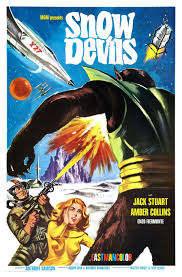
One of the quartet of Gamma 1 movies directed by Anthony Dawson aka Antonio Margheriti on whom more below.
Climate change is happening in 1967 and the crew of the Gamma 1 space wheel, which looks a lot like a blow-up water ring, are on the job. Ice caps are melting. Sun belts are flooding. Dust bowls are mud. Rivers are deserts. Deserts are teeming with wild flowers. The hills are alive with the…. Ooops. Getting off track.
Wait, no! It is not climate change, Erich. It is a team of alien NBA players in the stock footage of Edmund Hillary’s Himalayas turning the heat up and down. How they do this is anyone’s guess. The screenwriter did not bother trying to explain it.
These big, hairy aliens have come not to praise humanity but to bury it. Impatient with our efforts to murder ourselves, the aliens have come to speed catastrophe, bringing ballot boxes stuffed with
Russian votes for the Twit in Chief. What do they want? Real estate! When do they want it? Now!
Although we get early shots of the water ring in the space, it has nothing to do with the story. That’s the way it is.
The aliens start by wiping out a weather station in the mountains. Square Jaw and crew set out to see off these creatures. The girlfriend of one of the weather station personnel comes along to provide screaming. Girlfriend is no sooner there than she falls into the arms and related matter of Square Jaw. He is used to this and extends comfort to her. Missing boyfriend is forgotten.
There are nice touches that do not compensate for the runtime. When Square Jaw and his loyal band are taken captive, they engage in a speculation contest — think seminar —- to interpret what they see: The hairy apes tending the high tech volt meters. ‘The creatures are slaves. They are automatons doing the bidding of a higher intelligence.’ Then one of the apemen speaks to them in a BBC voice that one never hears on the BBC these days. What! The ape speaks! And he makes sense. This was the year before the reversal in ‘Planet of the Apes’ (1968) when Chest Heston spoke and made sense for the last time.
The boss ape’s argument is that humanity is doomed and the apemen are hitting fast forward because they need to relo. It seems one of their science experiments went wrong. They gotta go and fast. It unleashed a plague of GOPers on their home world. Following the Dr No playbook King Kong apeman shows-and-tells his whole set up to Square Jaw, including where the off-switch is.
There follows the escape of the captives who foil the plan. The end? Not quite.
Then it goes on. Yes that was only the first 45 llllooonnnggg minutes. The apemen have a second base, strangely it looks exactly like the one just destroyed. Square Jaw and his team attack it and destroy it. Is now the end….? There was tension among the fraternity brothers at this point. But yes, the end.
That the Yeti in the Himalayas might be superior beings waiting to claim the Earth once humanity committed Republicancide is brilliantly done in ‘The Abominable Snowman’ (1957), reviewed elsewhere on this blog. Nothing like that mystery and insight is to be found in this mishmash.
Antonio Margheriti (1930-2002) used the name Antony Dawson, and once, memorably, Anthony
Daisies, perhaps to avoid embarrassing his nearest and dearest. He started life as an engineer, shades of Roger Corman, and got into films as a technician. Once in the door there was no stopping him. IMDb credits him with fifty-seven films as director and scores of others as assistant director, producer, and special effects.
 Antonio Margheriti aka Anthony Dawson.
Antonio Margheriti aka Anthony Dawson.
His first feature film was Sy Fy, namely ‘Assignment: Outer Space’ (1960) followed by ‘Battle of the Worlds’ (1961), both reviewed elsewhere on this blog.
He established himself as a director who could produce a film with or without a budget. Accordingly producers gave him no rest. He was contracted to do four Sy Fy films and he did them all in three months, using the same sets, costumes, and actors. These titles live in infamy as the Gamma 1 quartet. All are reviewed on this blog, such is my commitment to serving readers.
‘Wild, Wild Planet’ (1966) ‘I Criminali della Galassia,’
’’War of the Planets’ (1965) ‘Diafanoidi Vengono da Marte,’
‘War between the Planets’ (1965) ‘Il Pianeta Errante,’and
‘Snow Devils’ (1965) ‘La Morte Viene dal Pianeta Aytin.’
There is no connection between the Italian titles and the English titles. There is little connection between either the Italian or English titles and the stories. Nor is there any connection of one story to another nor any continuing characters. Nor much of anything else.
‘Roving Mars’ (2006)
IMDb meta-data is 45 minutes of runtime, rated 7.3 by 936 cinemitizens.
Genre: Documentary
Verdict: More, please.
This is an account of the conception, development, production and preparation of Spirit and Opportunity bots to rove Mars. There follows launch, landing, and exploration. Where the cameras cannot go CGI does.
Challenges, there were a few. The rockets bearing the twins — Spirit and Opportunity — travel 12,000 miles per hour to cover the 40 million miles to Mars. But to land the rovers’ speeds have to be reduced to 12 miles per hour or less without damaging anything. ‘We can do this,’ mutter, the tech heads and set to work. This illustration is one of scores of such problems that had to be first identified, then analysed, and finally solved.
The robotic twins were designed to last three months. Yet on and on they have gone like good automatons. Spirit lasted from January 2005 to October 2010. Opportunity is still going! Go girl!
The names resulted from a competition among school children. The girl who submitted these two names was an adopted immigrant child.
 Nine-year old Sofi with one of her namelings. Her 40-word submission says more than the collected tweets of the Twit in Chief, and then some.
Nine-year old Sofi with one of her namelings. Her 40-word submission says more than the collected tweets of the Twit in Chief, and then some.
The assumption was that 90 solar days on Mars would be enough to extract data to prepare for the next mission. These two were rock choppers to gather that data. It was also assumed that after 90 days the ever-present dust on Mars would cover and clog the solar panels powering the rovers. Without battery power overnight, the rovers would freeze and rupture since it falls to -100F overnight. Do not believe the bare chested approach taken in ‘Robinson Crusoe on Mars’ (1967), reviewed elsewhere on this blog.
 Mars.
Mars.
The two rovers were put down on opposite sides of Mars to collect the geological data. They found evidence in worn rocks that there was once water on Mars. And where there was water there may have been life as science knows it.
Spirit broke a wheel and got stuck. All the details are on Wikipedia.
Each rover was handmade and rigorously tested, though no test on Earth equals the real thing on Mars. The unfolding arms were made by hand and tied into place with slipknots. A technician spend days tying the thirty-six knots on each arm, and then testing to see if they would indeed slip. And then doing it again, and again. Yep that is why she went to Cal Tech to do engineering, to tie shoe laces. There were many setbacks and much of the procedure was exhausting, and equally exhilarating.
The whole story is inspiring for even this jaded hack.
‘Moon Zero Two’ (1969)
IMDb meta-data is runtime of 1 hour and 40 minutes under-rated 4.2 by 1112 cinemitizens
Verdict: That it features Catherine Schell is the only thing the fraternity brothers noticed.
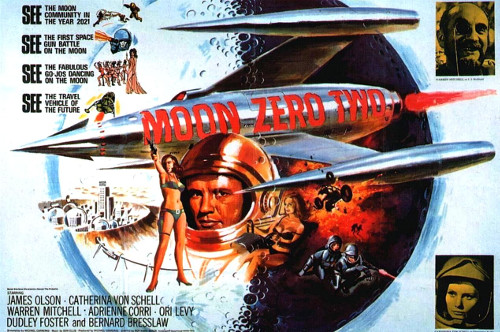
It opens with a silent sequence of five minutes as a space-suited figure leaves a lunar landing module in flight to retrieve a satellite. That was well done in an eerie and prolonged silence. No production would do that now with the attention-deficit audiences in every theatre only to ready to each for the smartphone.
It was an unexpected start, the more so after the long and loud credits which in retrospect seem to have been from a different movie; these credits are told in a cartoon of USSR and USA conflict over the moon. None of which is seen or mentioned thereafter in the film. Puts one in mind of Italian Sy Fy where scenes from other movies seen to wander in and out.
James Olson is the salvage space man using a very old LEM — three years from now — in 2021 when the Moon is so well colonised for mineral mining that there is a game called Moonopoly. It seems the Twit in Chief is still in office and there is no funding for spaceflight beyond the Moon. Twenty years ago in 2001 when men were still astronauts and he more hair Olson once landed on Mars but now no one wants to pay for another rocket to that dust bowl. So he is reduced to hunting for salvage in a dented old banger that cannot escape the Moon’s weak gravity.
It is a set up we have seen before in westerns, in sea stories, in…. [everything]. The rusticating professional gets involved with the greedy claim jumpers. Alf Garnett takes the villain duties a because Dr No was tied up with James Bond, and makes Olson an offer he cannot refuse: Enough Moon dust to buy his own interplanetary rocket.
Schell is looking for her missing mining brother by hanging around a saloon. She is new to the Moon and that excuses much exposition…..zzzzz’s were heard from the sofa. The saloon is a lender from ‘Gunsmoke.’
Guess! Turns out no dastardly deed is too small, and Alf Garnett and his posse have topped brother. There is much to’ing and fro’ing in miniatures. There is a gunfight on the Moon! Much stressed in the above lobby poster. There are some in-jokes alluding to ‘Space Odyssey 2001’ (1968). In the brightly coloured space suits on the Moon is a tribute to ‘Destination Moon’ (1951), reviewed elsewhere on this blog. Be nice if it was.
The acting is fine, apart from Alf as the ham off the bone, and most of the effects are adequate though none quite match the opening sequence. This is a Hammer Film Production at a time when Hammer owned the Horror genre. Perhaps some enthusiastic MBA wanted to return to Sy Fy, which is where Hammer started in the early 1950s. If so, it failed. While most of the cast is Brit, Olson is there for the American market, and he went from this to the ‘Andromeda Strain’ (1971) before concentrating on television. Of Katherina Freiin Schell von Bauschlott nothing more will be said. [Sigh.]
‘I criminali della galassia’ (1966) aka ‘Wild, Wild Planet’
IMDb meta-data is runtime of 1 hour and 33 minutes, over-rated 4.6 by 668 cinemitizens
Verdict: ‘Italian Sy Fy,’ that says it all.

In 1966 the television series ‘The Wild, Wild West’ (1965-1969) was hot on American television and the title of this exercise was changed for Yankee release to ‘Wild, Wild Planet.’ The Italian title, for the literal minded, is ‘The Galaxy Criminals’ and has as much relevance to the film as the alternative title: None.
A Mad Scientist, played with oily charm and face moles by Massimo Serato works for The CBM Corporation and is aboard a United Democracies Space Command space station – shot of the same space wheel from countless other Italian Sy Fy films. Commander Mike, who looks close to retirement, reluctantly plays the host offering up his girlfriend to Oily.
Oily works his wiles on Mike’s squeeze and off they go. Sniggering was heard from the fraternity bothers’ sofa. Mike looks none the wiser, and stays that way.
Meanwhile, bald men with wrap-around sunglasses wearing Nor‘easters are kidnapping 6000 people a day in one city alone. Wow! Those KPIs are something else!
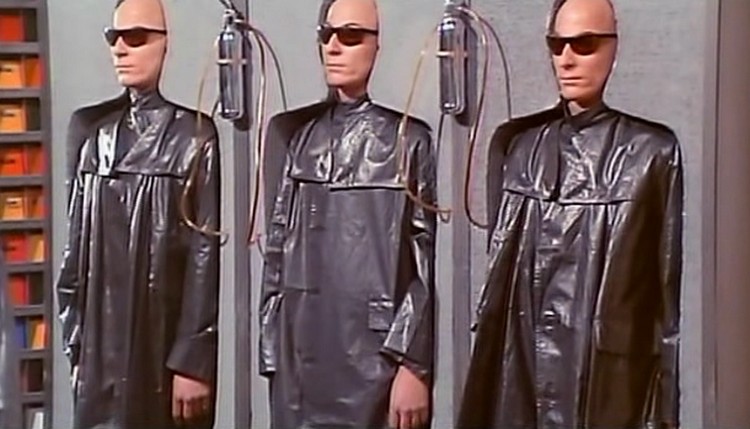 Here they are comatose at a training seminar.
Here they are comatose at a training seminar.
The authorities notice these disappearances, eventually. Italian bureaucracy is like that. This Herculean kidnapping labour is eased by the fact that the villains shrink the unconscious victims to pocket size. Oh, and the baldies also have four arms. Yup.
Since Commander Mike has nothing else to do now that Ms Squeeze is …., he investigates the disappearances. He does this work by answering the telephone. Exhausted. He rests.
Chin up, Reader. It gets worse.
Oily’s plan is to use the carefully selected kidnappees to create super race in Dr No’s lair, which Doc is subletting to Massimo. That is not the worst.
What’s worse? Here’s worse.
He has lured away Ms Squeeze, and it took little more than a crooked finger to do that, because he plans to join with her. ‘We knew that,’ chortled the fraternity brothers! Hang on, you dolts! Not like that. He plans to splice the two of them together with Dr No’s laser into one perfect being. How and why is not included in the screenplay.
What’s the word that comes to mind….? Nuts!
In this one instance alone I admit the fraternity brothers had the better idea.
Commander Mike blunders around with blow torches and saves the day. The lair is flooded with fatal tsunami of cherry Kool Aid. The end.
There is no galaxy in sight, nor any planet. The only wild part is the 1960s use of primary colours.
The effects are straight from a primary school classroom. Credit the players for trying and among their number is Franco Nero, who now wishes he had used a pseudonym. The production team made three more films of this ilk, reviewed on this blog, ‘Battle of the Worlds’ (1961), ‘War Between the Planets’ (1966), and ‘Snow Devils’ (1967). The same shots of the space wheel appear in each.
‘Slow Horses’ (2010) and ‘The List’ (2017) by Mick Herron
Genre: Thriller. Goodreads meta-data: 3.84 / 5 by 4852 litizens.
Verdict: 5, a classic of its kind.
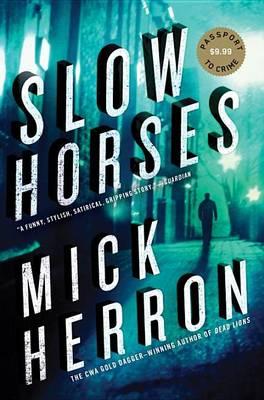
MI5 agent Cartwright fails a training exercise and is exiled to the outer darkness of Slough House, which like all that follows is not what it seems. It is neither in Slough nor is it a house. In this world nothing is as it seems. Nothing and no one.
Cartwright, a grandson of Callan who is an MI5 legend, and much of that organisation’s purpose now is terrorism of one kind of another, but when all the hedges are said and done, the Islamic kind. Though the office politics uses the dead language of McKinsey speak that is but a screen for a far more primitive and brutal kind of competition for status, turf, and career, which is waged more seriously than that against terrorism.
Spoiler alert. It is beyond me to describe the book without giving away the plot. Read no further if apt to read the book. STOP.
Cartwright finds there at the remote station in the outer darkness of London other MI5 rejects who are assigned meaningless work to keep them busy and to encourage them to resign from the Service. They number about a dozen under the sleepy gaze of Lamb upstairs. Unkept, unshaven, unwashed, untidy Lamb dozes the day away and drinks the night away. His supervision seems to be part of the punishment. This set-up does sound like the McKinsey seminar on managing-out the KPI failures, by sending them to the circles of Dante’s Hell otherwise known as training seminars and workshops until they crack. This method is necessary since it is no longer possible to dismiss someone for incompetence. Discrimination against the incompetent is verboten. Incompetence is a syndrome for which the society is responsible, not the individual, their barristers will argue. Amen.
The twist in the tale is that whitebread anti-terrorist vigilantes decide to up the ante by kidnapping a London schoolboy of Pakistani derivation and decapitate him on an internet feed. The three villains are as nasty and stupid as the target demographic of 7Mate. In hindsight there are several false notes. The kidnapping is too smooth for these bumblers to have managed. Moreover, the internet feed is technologically several miles above their ability with light switches. Still it gets things rolling.
In reaction there are wheels within wheels within wheels where some of the senior people in the Service use this event for career purposes, and worse. When things go wrong, as inevitably they must to make it a thriller, the best way to conceal those careerist manipulations is to blame the whole mess on the expendable denizens of Slough House. This turn of events rouses the sleeping lion that is Lamb to action and he motivates (most of) his crew to defend themselves from their own. This brief transformation occurs when he points out their likely fate if they wait for the blame bat to splatter them across the floor of a secret and illegal prison in Bulgaria which does not exist, officially.
‘Most’ not all, because three of the crew are only too ready to perjure and prostitute themselves to sell out Lamb and the others for the promise of a promotion. That corporate immorality certainly sounds plausible in any large organisation where backstabbing is the way ahead and scruples are not quantified among the KPIs. It is comforting to know that this is a general phenomenon.
Motivated by survival, the remainder of the crew takes action. Most of it is an internal conflict among factions in MI5 which has burgeoned with a budget swollen to match the anti-terrorism rhetoric of the age. And with a political class that does not want to know unpleasant things but wants them to go away. On the penchant for ‘smooth things’ see Isaiah 30:10.
Other characters include a rabid journalist whose extremism has gone even beyond the Fox News pale, if that is possible. That seemed another false note. There is no line of decency that Faux News will not cross, lemmings in tow. In turn, this journo has contacts in the respectable right of the Conservative Party in the person of an aspiring Leader who has verisimilitude.
It is a thriller and there is an axe, a ticking package, and a pistol, and the body count is three, but most of the decisive events occur in offices, albeit once after a beating, and the files do yield the ore of truth. Well, the body count comes to four, because by the sheerest of coincidences after the journo threatens the leadership aspirant he meets an untimely end a few days later on a zebra crossing. That problem went away.
The kidnap victim proves equal to the circumstance in unexpected ways that are yet plausible. Ditto the other characters.
That is the achievement of Herron to vivify a gallery of diverse and credible characters. The telling is that truncated and cross-cut style of the thriller that I dislike but in this instance it works, and I swallowed my objection as I turned the pages. At the start my aim to satisfy the recommendation of a friend, but soon I was reading under my own power.
It sounds like John Le Carré’s Cold War spy novels and it is. When the Cold War ended Le Carré tried other settings and the ones I read did not hit the mark for me. Without Smiley and Karla, well it all seemed like dog paddling in the shallow end.
Herron brings that grey world of spy and counterspy to the War on Terror with great panache and insight. Alec Leamas would fit in at Slough House. Indeed he might be the model for Lamb. However, reflection on the Cold War versions, not forgetting Len Deighton, brings to light a new element and that is the pathological dysfunction of the organisation. In Smiley’s world there were traitors like Bill Hayden, and hellbent careerists like Saul Enderby, too, but they were not yet ready to eat their own for new office furniture. They were many things but not the vampires, cannibals, and zombies that comprise MI5 in these pages.
The book offers a primer in the tradecraft of MI5, London Rules, joes, achievers, dogs, suits, black files, street walkers, grey books, and the like. I am sucker for that stuff and ate it with a spoon.
 Mick Herron
Mick Herron
‘The List’ is a novella that I read it about an hour and a half. It is cut from the same cloth as above, but the ambit is much smaller. My reading was slowed by guffaws and snorts at the characterisations and descriptions. Herron can turn a phrase, pin a butterfly to a board, nail a metaphor, all with the mordant wit of a bored viper.
In this brief tale, Five outsmarts itself in an exercise of double and triple duplicity. Lamb smells it but keeps silent for his own reasons, letting fools (who think they are so smart and so cynical) rush in. They do.
‘Indignation’ (2008) by Philip Roth.
…. in which an immature boy from New Jersey goes to college in Winesburg Ohio. He makes few friends and falls in lust. It is 1950 and when he is expelled, then he is drafted and dies in Korea.

Meta-data from Good Reads is 3.7/5 from 11959 litizens.
Verdict: Ah, now I remember why I do not read novels by Philip Roth.
Our hero is Messner who dislikes other Jews he meets in Ohio, cannot get along with Gentiles who befriend him, and is attracted and repelled by the only co-ed who knows he exists. With the auto-didacticism of youth he spouts ill digested bon mots from Bertrand Russell.
On the one hand he is typical of a nineteen-year old in all this and on the other he has not got the sense to stop. His self-destructive streak has no rhyme or reason but the needs of the author to make him and vicariously himself (the author) into a victim. Young men are often as stupid as Messner but they grow up little-by-little but not so here in either case.
HIs expulsion arises in this way. He hates attending Chapel, not on religious grounds, but because it is boring. He hires a substitute to go in his place. This fact is revealed by one of the many people he antagonises and when confronted with the fact he is defiant. Expulsion follows.
(I attended Chapel in a similar fashion and found it often boring, but not always. It was sometimes an opportunity for rest, if not reflection. At other times I heard Basil Rathbone read Shakespeare, Robert Penn Warren recite poetry, Ernie Chambers call blacks to arms, Sarah Gardner make science wonderful, Alexander Kerensky mourn the missed opportunities of 1917, Paul Tillich bring the New Testament to life, and a stage set designer whose name has been lost talk about how to stage Greek tragedy in a contemporary theatre, and more that I can no longer remember. More’s the pity. Thereafter with new eyes I saw Shakespeare, read ‘All the King’s Men,’ followed Senator Chambers’s career, found Tillich in utopia, and watched Sophocles.)
It is the usual from Philip Roth, to my mind ever an greying instance of arrested development. He is totally focused on his ….. first friend. He and Silvio Berlusconi are cut from the same cloth. Neither Messner, the paper protagonist, nor Roth, the writer, shows any interest in Olivia, the co-ed, except insofar as she relates to his first friend.
The style is simple and that is a relief as the pages are free from the lengthy and pointless descriptions that encrust other of his novels which I have sampled. Ergo it is easy to read. The style, one supposes, is to match the voice of the man-boy Messner. In that it succeeds.
The title is ironic. Throughout Messner, transfixed by the Korean War, recites a phrase from the People’s Republic of China’s national anthem long before it entered the war. In Korea at a map reference he is killed by Chinese, we must suppose. That all goes beyond heavy-handed to lead-handed. There is never any explanation of how and why Messner has latched onto this passage. It is just the author’s vanity intruding. Did I mention that Messner was dead all along. I did not much care. Not true, I did not care at all.
Here is a comparison. This Messner is about the same age as William Styron when he wrote ‘Lie Down in Darkness’ (1951) at the time ‘Indignation’ is set. ‘Lie Down in Darkness’ is a tour de force novel. Friends of Roth, parading as critics, say ‘Indignation’ is a character study. Ha! ‘Lie Down in Darkness’ is a trip into mental illness that is exhilarating, compelling, and frightening. By the way Styron was a Marine and his take on the Korean War is in ‘The Long March’ (1954).
The setting must have been a deliberate reference to Sherwood Anderson’s ‘Winesburg’ (1919) which is a series of short stories that together present the inhabitants of a Winesburg Ohio. Anderson’s prose is supple and evocative. The people come to life off the page. A reader feels the breeze from the river and hears the quiet sobs from behind closed windows with a minimum of words. It is no wonder that the young William Faulkner sat at Anderson’s feet.
 Philip Roth
Philip Roth
I found Roth’s novel boring and cold. I persisted to honour the gift it was from a friend.
The novel was filmed in 2016. Go for it but don’t say there was no warning.
‘Jungle Captive’ (1945)
IMDb meta-data is runtime of 1 hour and 3 minutes, rated 5.4 by 242 cinemitizens.
Verdict: There is no jungle and no captive. The last and least of the Ape Woman three-part franchise.

A sedate mad scientist brings Paula Dupree back to life — again!—- and prepares her for a brain transplant. If the latter is successful perhaps it can be applied to Republicans.
The gimmick here is that the mad scientist is in plain sight as the mild mannered Stendahl who is ever so polite, calm, and reassuring, even as he approaches with that big needle in one hand and knife in the hand behind his back. He is a Mr and not a Dr but he is nuts all the same. A doctor’s degree is not necessary to be crazy, though it is a first step for many.
 Evil Otto
Evil Otto
His laboratory assistants fail to notice his psychosis until he approaches them, for blood, for a brain, for a quarter to put in the clothes dryer. Jerome Cowan, who often played light, is the plod on the job, and not a dumb as he looks.
The assistants are an item but are both so bland, no one notices.
More distinctive is Rondo Hatton as Stendahl’s disloyal accomplice, Moloch, who draws a moral line. That name says it all. Hondo has more dialogue here than any of his other roles. He was a Doughboy in the Great War where he was gassed. The consequence was acromegaly which caused deformation of the bones and tissues of the extremities.
 Rondo before and after.
Rondo before and after.
His freakish appearance got him noticed by Hollywood and he eked out a living as a celluloid brute, usually silent, in small parts in twenty-five films, often uncredited, until his premature death.
The smooth, attractive, well-spoken doctor is a murderous, insane criminal, while Moloch who looks and moves like a freak has a conscience and moral sense both of which the doctor lacks in his KPIs. That was a nice twist.
Why this scientist should be a misspelled French novelist is a poser. The mad scientist Otto Kruger has neither the intensity of John Carradine not the depravity of Erich von Stroheim, both masters of such a role.
The Ape Woman franchise was the effort of Universal Studios to stake new ground in the genre it had pioneered, namely Horror, with a female monster. A good idea at time, perhaps, but the execution did not establish it. The first film is very well made but the cinematography and stagecraft could not conceal a one-idea script though the aforementioned Carradine as the villain carries it off. That was ‘Captive Wild Woman’ (1943). The second, ‘Jungle Woman’ (1944), did not have even one idea to justify its existence. Paula was resuscitated in this one, too. Cannot keep a good Ape Woman down for long.
‘Queen of Blood’ (1966)
IMDb meta-data is runtime 1 hour and 18 minutes, rated 5.3 by 1231 cinemitizens
Verdict: Better than many of its kind. Atta girl!
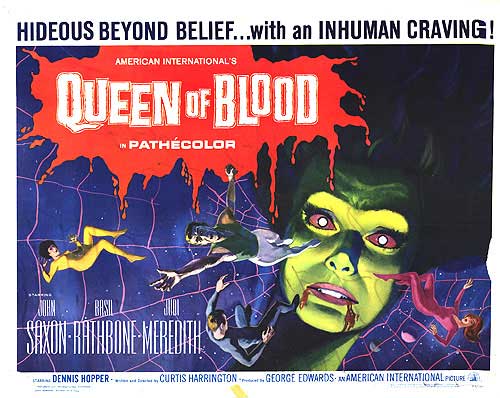
In distant 1990 lunar travel is routine and on Moon Base One plans advance for flights to Venus and to Mars. On earth all is peace and goodwill. Yes, fiction alright.
Sherlock Holmes, clipboard in hand, runs the show. Carmine Orrico will board the Venus flight and Judi will go to Mars. Judi and Carmine are an item. Her flight will be first and Carmine accepts that with good cheer and moral support. Already there are differences from others of this ilk. The woman is an astronaut, not a nutritionist, coffee bearer, or object of either sexism or comic distress. She is just there to do a job. Moreover, Carmine is urging her on.
Wait! Before the off there comes into this carefully planned (see clipboard for details) program a message from the stars. SETI answers. Dit-dat-dat-dot it goes and by consulting the screenplay they can decipher this static as: ‘Hello! Our ambassador is on the way in a spaceship.’
Anticipation moves Sherlock to give a speech. Mercifully brief. Wisely he does not tell Faux News.
Next thing another message arrives. This one is a video log. Check the release data above. Somehow these star travelling aliens have managed to transmit a smartphone video log to the Moonies.
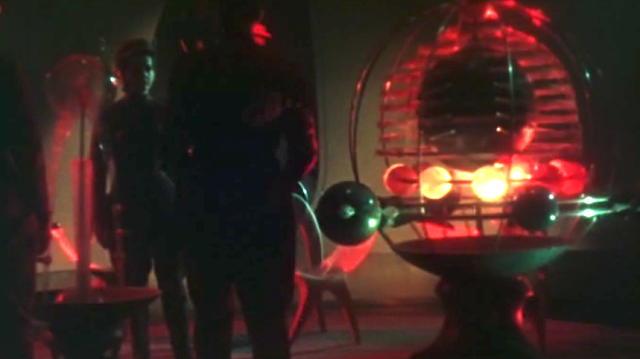 The alien ship.
The alien ship.
It is exotic indeed, this video. It is from the ambassador-bearing ship which, by relying on Apple Maps hit Mars instead of Earth and has crashed. ‘Help!’ is this second message.
All hands to the clichés! They launch the Mars rocket first and Judi goes. Carmine mopes. Of course things go wrong. then Carmine tanks up his rocket to go to the rescue. No Apple maps for him! It’s Rand McNally or bust!
Meanwhile, Judi and company have found the alien ship. More moody, exotic interiors, where they find one dead green skin and another barely alive whom they cart to their damaged ship. Humanoid it seems. More so than most Republicans in Congress. Female it seems with a beehive hairdo, sort of. Let’s call her Queenie for reasons to be explained.
She revives. Easy Rider nurses her back to health. So he thinks. Meanwhile she examines the menu. By now Carmine has arrived. We have a full complement on the spaceship of Otranto. But not for long.
Queenie dilates her eyes and Easy Rider falls at her feet. He is the first course. Yum! Yum!
The fraternity brothers loved what came next.
Captain Science, Carmine, and Judi find Easy Rider deceased. Queenie is still licking his blood from her lips.
Hmm. Captain Science is not sure she did it. He is obtuse enough to be a professor. ‘Of course she did it,’ shouts Carmine! Grudgingly Captain Science admits she must have. But he says — get this — ‘We cannot judge her!’ ‘What [bleep, bleep],’ shouts Carmine! ‘We sure can!’
It was all too much like a cultural sensitivity training course, or worse, a snowflake seminar.
‘No, no,’ says Captain Science. ‘Murder and cannibalism are just her cultural ways which we must respect.’ Carmine proposes that she respect his cultural ways while he puts a pistol to her head. ‘No, no’ reiterates Captain Science: What we do is we tie her up and feed her on the blood plasma [we carry for just such emergencies] during the return flight. Is there a shortage of vampires in Hollywood that they have to import another one? So asked the fraternity brothers.
And — get this! — continues Captain Science, if we run low on blood plasma, then we will have to….. Yes, drain our blood for her dinner. Carmine is not on board for this. Captain Science is so unfit for command, I wondered why he was not POTUS.
Any guesses for where this going?
None of them were ever Boy Scouts so when it comes to knots, tying shoes laces is it. Slip knots are called that for a reason. Having slept off digesting Easy Rider, she waltzes free the moment she wakes up.
She dilates her eyes again and the Captain Science drops his test tubes. Two down. Victims of cultural relativity.
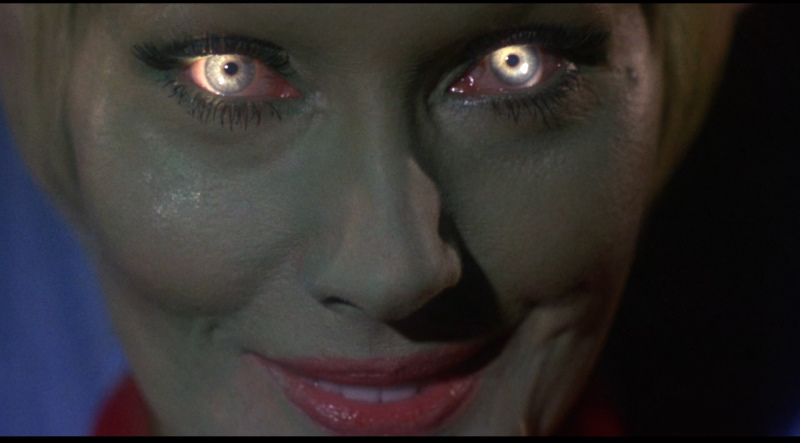 The eyes will have it!
The eyes will have it!
Carmine calls Sherlock who tells him to man-up because Queenie is more important than a couple of underlings. There is an ominous implication that the loss of a couple more underlings named Carmine and Judi would not phase Sherlock one bit. ‘Bring her in, unharmed,’ he orders. They shoe lace her up again.
Got it? Yep. She is free again and has eyes for Carmine. He is pasta in her hands and she is about to dine when…..
Judi crashes the party, belts her, and scratches Queenie’s shoulder. Queenie runs off in a snit. Carmine regains such consciousness as he has. Slugger Judi dusts her knuckles.
Unarmed Judi and Carmine set off to find her. Dumb, but turns out Queenie is royalty and green-bled to death. That very big word ‘haemophilia’ was used much to the annoyance of the fraternity brothers who reached for the aspirin. Evidently all royals are bleeders. Hence the title ‘Queen of Blood.’
They speculate that Queenie was a telepath who could control men, but not women. The fraternity brothers scoffed at that conclusion. Oola, who was green, had no need of telepathy to control them.
They land and Sherlock is happy enough with an autopsy. The end.
That Kingie might come in search of Queenie does not cross a page of the script. That they have been party to the death of the first two aliens they have met gives no pause for remorse. Instead we have the eggs she has hidden on board, which Sherlock wants for an omelet. She is a queen in another way, a Queen Bee or a Queen Ant. That explains her hunger. Yeah, right.
It was marketed under several other titles to catch unwary theatregoers, including ‘Planet of Blood,’ ‘Planet of Terror,’ ‘Planet of Vampires,’ and ‘The Green Woman.’ None of it takes place on a planet; another triumph from the marketing department. Since there is only one, the plural is also erroneous. Green, yes, that is conceded.
Get this, jaded Reader: Not only does no one deprecate the woman astronaut, but she saves the day. Go girl!
Moreover, no one smokes. In era when an actor could not play a scientist without a pipe there are no pipes, and no ciggies either.
The alien space ship scenes were cut from a Russian Sy Fy film and pasted into this one. That inserting was often done in Roger Corman productions, but in this case it was well done, which was not often done in Roger Corman productions. The lighting, set design, and camera work is such that the seams do not show. Curtis Harrington was the director and he made maximum use of these aspects to create an eerie, mysterious, and alien atmosphere.
He later directed Debbie Reynolds, Simone Signoret, Katherine Ross, and Shelly Winters in other films. Impressive. He often worked in television. The black widow is a theme in a number of his other works, some of which he wrote, as he did this title. He wrote the story around the available footage from the Soviet film, whereas in most Corman productions the Soviet footage was shoe-horned into a story that was already written or even filmed, and it always showed.
Carmine had his first role in 1954, and he is still at it with a 2018 credit and 200 others in between. Those monkey glands must work a treat. His reputation remains as, hmm, someone with interesting lifestyle choices even by Hollywood standards. Johnny Depp is a homeboy in comparison.
This film was made simultaneously with another Roger Corman production, ‘Voyage to the Prehistoric Planet’ (1965), also derived from cuttings of the same Russkie movie, reviewed elsewhere on this blog. Keeping his white coat on and clipboard in hand, Sherlock walked from one side of the set to the other to do his lines for the other film. The man was the consummate professional, doing two roles in two different movies at once. Curtis Harrington directed that, too, but chose a pseudonym to protect the guilty.
Corman bought Russian Sy Fy films for two reasons, and in this order. First, they were cheap. Second they had superior special effects, though these were often mangled when inserted into Corman productions. The word on the internet street is that in 1950s when the Space Race began, some wits in Soviet policy decided to enthuse the populace for space with Sy Fy films and budgeted for the special effects. That is what caught Corman’s eye.
‘Jungle Woman’ (1944)
IMDb meta-data: 1 hour and 1 minute to treacle time, rated an astounding 5.2 by 277 masochists.
Verdict: a creature feature devoid of both.
Universal Studios broke the gender barrier in creature features with a trilogy of wild, captive, and jungle women films. This is the second instalment on this mercifully short-lived franchise.
The first was ‘Captive Wild Woman’ (1943), reviewed elsewhere on this blog. This earlier film was a masterclass in making something from the nothing on a micro-budget. A third of that film’s one hour time was clipped from a still earlier Universal film, ‘The Big Cage’ (1933). But director Edward Dymtryk did it so well, there was no distraction. Not so here.
About a quarter of the runtime of this treacle is excerpted from ‘Captive Wild Woman’ (which excerpts include scenes from ‘The Big Cage’ as explained above). In this movie the underside of the weave shows. To accommodate this earlier material much of this script is set out in flashbacks. Long before Roger Corman this studio had learned to plagiarise itself.

Evelyn Ankers is top billed but has but one opening scene of three minutes and then disappears. In fact that scene is a lift from ‘Captive Wild Woman,’ recycled here. Ditto Dr Adams. The ever reliable Douglas Dumbrille has one early scene and is gone.
There is no jungle and no woman to speak of, though Acquanetta reprises her role as Cheela the ape come human. This time she speaks. What a mistake that was. Silent, she had mystery. Speaking she had adenoids.
A screen shot of Cheela from the earlier film is included for, the fraternity brothers timed it, five seconds, and that is it. That does not a creature feature make.
Not only is there no creature in this feature, there is also no mad scientist. In the earlier film John Carradine filled this vacuum perfectly. Here we have a kindly doctor who by circumstance finds the ape woman on his rounds. J. Carrol Naish brings a calm and reflective intensity to this role, which in other material would have been compelling, but here, it is undercut by the crude simplicity of the sieved pot boiler in which the role is immersed.
Universal had made a place for itself in cinema-land in the 1930s with horror films. Indeed some pundits credit it with establishing that genre in films with such masterpieces as ‘Frankenstein’ (1931). In this franchise it previously broached the gender line with ‘Bride of Frankenstein’ (1935) where Elsa Lancaster stole that show.
How low could Universal go? Well, that will be seen in the third movie in this Jungle franchise, ‘Jungle Captive’ (1945). Scuba gear maybe required.
‘109 East Palace: Robert Oppenheimer and the Secret City of Los Alamos’ (2006) by Jennet Conant.
Good Reads meta-data Rating: 4 from 1,234 votes. 425 pages.
Verdict: not the biography of Oppenheimer I was looking for.

The development of Atomic Bomb in twenty-seven months on a mesa in New Mexico is quite a story from theory to practice.
The book offers a near day-by-day account mostly of the administrivia of Los Alamos. Largely told through the subsequent recollections of the office manager of the project, located at 109 East Palace Street in Santa Fe, Dorothy McKibben, who adored Oppenheimer. In silence the author credits Dorothy with a remarkable and flawless memory for conversations because she recalled them years later without the benefit of diary or any other written record from the time.
Only 40% of the way through the book did this reader notice any discussion of the engineering, technical, and scientific endeavours. Apart from listening to complaints about laundry and indulging the pranks of immature minds, Oppenheimer never comes into focus in these pages despite his image on the cover and his name in the title.
These impressions are not helped by the slangy style of exposition and the credulity of the author who takes as fact whatever a favoured source said. This reader got no sense that any assertions were double checked. In addition, facts were scarce. I never did get an idea how big the operation was. Only more than half way through are some numbers mentioned, e.g., 3,000 but given the one-eyed perspective of the author I was unsure who was included in that number.
I said one-eyed because the author is always on the side of the scientists, say when they complained about secrecy and security and seems repeatedly to belittle both the GIs who built most of the set-up and the intelligence agents who censored the mail, kept strangers away, demanded to see passes, and so on.
The immaturity of many of the scientists involved is breath-taking, the more so later when some of the same individuals took it upon themselves later to pontificate about the use of the Bomb. Even the fraternity brothers paled at some of their antics. While some of these draft-exempt scientists were planning panty-raids, in 1944 the Pentagon was sending 2000 yellow telegrams a day to mothers and wives.
Most of the Europeans on the project were more serious because Naziism was a reality to them, and not a newsreel. Indeed so focused were they on Germany that when the war ended in Europe many wanted to quit the project. They had so quarrel with Japan since it had no bomb and no prospect of one. Their goal was to get to the Bomb before the Naziis did.
At this point Oppenheimer was, it seems, crucial in motivating them to work ever harder, far from quitting. That he did this is, however, not explained by anything in his nature or character developed earlier in the book. Yet it was certainly crucial and he was the one who did it. We did get earlier the grudging admission by one of his many critics that Oppenheimer, despite his dilettantish pre-war mien, had proven adept at getting all those (egotistical) scientists to talk to each other. No mean feat that. More exposition of how that was managed would be welcome.
There are many assertions that Oppenheimer was attractive to women, that he had blue eyes, and a confident manner. So what? There are many of these and none of them built the bomb. There had to be more than these superficial descriptions to explain his singular achievements as noted in the paragraph above. Using the word ‘charisma’ is neither analysis nor explanation.
Oppenheimer is the centre of the book, even if he is seldom on the page. His own disregard of security is numbing. Why did he do those things that later would look so damning? My own conclusion is hubris. In the first instance Oppenheimer was sure, because he was so much smarter than everyone else, he would never make a mistake and give anything away, no matter to whom he talked. Second, he was likewise sure he would always be able to talk his way out of suspicion. So he thought.
Instead he simply called attention to himself again and again, and it stuck. And he created a pattern that was at best reckless and at worst sinister.
That a skilled intelligence agent could learn much from what is not said, or from the lies told, these are tricks of the spy trade that Oppenheimer never considered, since his hubris meant he never thought anyone else could out think him.
His hubris had another strand. After the war, he could have gone back to Cal and time might have healed some of the wounds, but instead he haunted Washington, putting himself forward as Mr. Atom, advocating committees, and himself as a member. He was hard to miss. He had come to view himself as indispensable. Maybe he was, but the effect, given the two strands already mentioned, was to make himself into a target. He seems always to think he was an invulnerable Achilles.
While the author mocks the efforts of the security officers with the fact that they missed Klaus Fuchs, who was indeed passing information to Them, she seems to fail to see that the security officers were right. There were leaks. Fuchs, by the way, was not the only source of leaks but the most well placed.
Nor does the author indicate any effort at ascertaining, say by visiting the National Archives, whether German agents were active in the matter. Still less other Soviet agents who monitored Oppenheimer when he was away, as was often, from Los Alamos.
The drama accelerates quickly in the middle of the book, and we read less about bickering, picnicking, and laundry, when it is time to test Trinity.
 The Trinity test at 10 seconds after detonation.
The Trinity test at 10 seconds after detonation.
Though here, as always, is a squabble about the name which is dutifully recorded by the author.
Yet she sits on the fence about the use of the bomb. She quotes estimates of causalities of the projected November 1946 invasion of Japan and then in a rare footnote says this figure might have been fabricated. That is quite an accusation to make in a throwaway footnote. It is a fact, by the way, that the Pentagon planners had begun preparations for 500,000 American casualties from an invasion of Japan. It had also contracted for 10,000 yellow telegrams a day.
What president would not use the bomb in preference to such a toll?
Given the many uncertainties involved with the Bomb, the only way to go was to use it. Why? What demonstration would convince the Japanese? Blow up an uninhabited island? Not likely to be convincing. They would suspect a trick. That the Bomb would even work was always in doubt. If it did not work on the island, then it would serve no purpose but waste the weapon and do so in a way that nothing could be learned from the failure. And a failed demonstration would queer the pitch for another demonstration.
Moreover, the weapons grade uranium was so scarce and hard to use that wasting a Bomb on an island might mean another one was not available for some time. Furthermore transporting the Bomb to the Pacific was hard. The cruiser USS Indianapolis that delivered the first Bomb was sunk by a Japanese submarine a few days after completing that mission. (See ‘Jaws’ [1975] for confirmation.) Would the next ship transporting a bomb be sunk with it on board?
The prospect of besieging Japan into surrender was considered and rejected on many grounds. The Soviet Union would nibble away at Japanese weaknesses, while leaving the hard work to the United States. Little material support would come from a depleted England. The Chinese would turn full-time to fighting among themselves. During a prolonged siege the young, the women, and the civilians would suffer most as scarce resources would go to the defence forces. The result would be to cripple Japan for a generation or more without discrediting or displacing the war party.
Douglas McArthur always preferred manoeuvre and surprise to direct attacks, but he saw no other way in 1945.
The zealots in Japan were ready to fight on, and the example of Okinawa frightened everyone in the Pentagon. They would fight to the death unless the Emperor ordered them not to do so. To get to that order, the zealots had to be completely undermined. Hence the first big bang. It was made all the more dramatic for being a single aircraft. Japanese air defence spotted it but did not respond to its approach, assuming it was photographic reconnaissance.
In the two-day interval allowed for the Japanese to assess the destruction of Hiroshima, we now know what was unknown in D.C. at the time, that there was an abortive coup d’état, but it came to nothing. The second bomb, by the way, was not targeted on Nagasaki but bad weather took it there.
Back to the book in hand, the author seems to relish name dropping, as if everyone associated with a notable university is somehow a superior person. I could only put this down to an ingrained snobbery. This attitude shows also in the way those who were not blessed with such illustrious associations are portrayed. General Lesley Groves is one example. He, more often than not, is portrayed just one step away from Groucho Marx. Yet he oversaw an unprecedented and wide-spread effort of which Los Alamos was only a part, but he gets barely any credit, until, perhaps at the urging of editor, some condescending good words are applied toward the end. But overall the tone is, how could this nobody criticise these men from prestigious universities. Yes, Groves had an MIT degree, but he was but a student there, and in those days, by the way, MIT did not have the caché it does now, partly thanks to graduates like Groves.
Yet the text shows he was right about many things, like the irresponsibility of some of the scientists, about the need for secrecy, about the dubious nature of the undertaking, about the subsequent need to explain and justify everything done, and even the spies. More importantly, that he stuck by Oppenheimer as the right man for the job even though he did not like him.
The author has an admirable list of titles on related subjects.

So be it. Not for me. Reading this book but confirms my cynicism about the world of New York City publishing.
